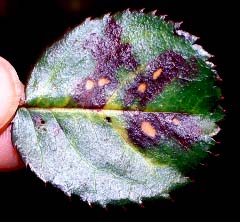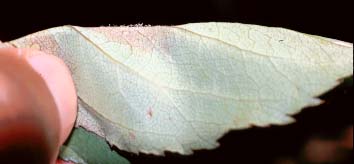
Notice the purplish irregular blotches as well as the necrotic areas sometimes attributed to pesticide burn.
CAUSAL ORGANISM: Peronospora sparsa
Downy Mildew is a very common disease of roses which occurs under moist cloudy conditions. The disease is found throughout the united states, Europe and South America. All species of cultivated and wild rose seem to be susceptible.
SYMPTOMS: Under cool and moist spring conditions, young leaves stems and flowers may manifest purple to red or brown irregular spots. As the disease advances, lesions on leaves become angular and black with the possible appearance of white mycelium on the underside of the leaf. Advanced infections will have yellowing of leaves with brown necrotic areas and noticeable leaf abscission. As the scientific name indicates, the production of spores is sparse and therefore this disease is difficult to diagnose. Along the coast of California where moist cloudy conditions persist through summer, the disease is severe and can occur on large canes as purple irregular blotches.

Notice the purplish irregular blotches as well as the necrotic areas sometimes attributed to pesticide burn.

Notice the purplish irregular blotches as well as the necrotic areas sometimes attributed to pesticide burn.

Side view of an infected leaf. Notice the fine whitish mycelia near the midrib of the leaf. This is the location directly under one of the purple blotches.
DISEASE CYCLE: The fungus can over winter as mycelium or oospores in or on plant parts. Upon favorable conditions growth resumes with intercellular development of mycelia and production of oospores in as little as three days. Oospores can be wind or water borne and germinate to form sporangia. The sporangia can germinate directly or form zoospores which swim in free water on the plant surfaces. Encysted zoospores or sporangia germinate and penetrate the leaf surface producing intercellular mycelium. As development progresses sporangiophores are pushed through stomata on the underside of leaves and sporangia or oospores are formed to complete the life cycle.
CONTROL: This disease can be especially severe on greenhouse grown roses where humid conditions exist for long time periods. Ventilation and reducing humidity below 85% will reduce disease development. Sanitation in the garden will reduce the primary source of inoculum. Where damp humid conditions exist systemic fungicides containing metalaxyl will give some control. Other fungicides can also be used but the persistence of the material through wet periods or rain is important to maintain protection.
ACKNOWLEDGEMENTS: I would like to thank the following plant pathologists with the California Department of Food and Agriculture's Plant Pests Diagnostic Centre: Dan Opgenorth, Diana Foggle, and Tim Tidwell. They have given me invaluable advice in preparing this article. All the above pictures of the disease were taken by Baldo Villegas.
Horst, R. K. 1983. Compendium of Rose Diseases. The American Phytopathological Society, St. Paul, Minnesota. Pp. 13-14 and Color Plates 26-29.
![]()
If you have any questions or constructive comments, I would love to hear from you, please send e-mail to Baldo Villegas
[Home]
[Rose Pests Master List]
[Rose Diseases]
[Insect, Mites, and other Animal Pests]
[Abiotic Rose Problems]
[Weed Pests]
[Hawaii Pests]
[The Good Guys]
[Help! Rose IPM]
[Horticulure Links]
Copyright© 1995-2005 by Baldo Villegas
Last updated:
Wednesday, October 26, 2005 10:18 PM